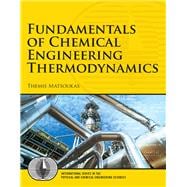
Acknowledgments xvii
About the Author xix
Nomenclature xxi
Part I: Pure Fluids 1
Chapter 1: Scope and Language of Thermodynamics 3
1.1 Molecular Basis of Thermodynamics 5
1.2 Statistical versus Classical Thermodynamics 11
1.3 Definitions 13
1.4 Units 22
1.5 Summary 26
1.6 Problems 26
Chapter 2: Phase Diagrams of Pure Fluids 29
2.1 The PVT Behavior of Pure Fluid 29
2.2 Tabulation of Properties 40
2.3 Compressibility Factor and the ZP Graph 43
2.4 Corresponding States 45
2.5 Virial Equation 53
2.6 Cubic Equations of State 57
2.7 PVT Behavior of Cubic Equations of State 61
2.8 Working with Cubic Equations 64
2.9 Other Equations of State 67
2.10 Thermal Expansion and Isothermal Compression 71
2.11 Empirical Equations for Density 72
2.12 Summary 77
2.13 Problems 78
Chapter 3: Energy and the First Law 87
3.1 Energy and Mechanical Work 88
3.2 Shaft Work and PV Work 90
3.3 Internal Energy and Heat 96
3.4 First Law for a Closed System 98
3.5 Elementary Paths 101
3.6 Sensible Heat–Heat Capacities 109
3.7 Heat of Vaporization 119
3.8 Ideal-Gas State 124
3.9 Energy Balances and Irreversible Processes 133
3.10 Summary 139
3.11 Problems 140
Chapter 4: Entropy and the Second Law 149
4.1 The Second Law in a Closed System 150
4.2 Calculation of Entropy 153
4.3 Energy Balances Using Entropy 163
4.4 Entropy Generation 167
4.5 Carnot Cycle 168
4.6 Alternative Statements of the Second Law 177
4.7 Ideal and Lost Work 183
4.8 Ambient Surroundings as a Default Bath–Exergy 189
4.9 Equilibrium and Stability 191
4.10 Molecular View of Entropy 195
4.11 Summary 199
4.12 Problems 201
Chapter 5: Calculation of Properties 205
5.1 Calculus of Thermodynamics 205
5.2 Integration of Differentials 213
5.3 Fundamental Relationships 214
5.4 Equations for Enthalpy and Entropy 217
5.5 Ideal-Gas State 219
5.6 Incompressible Phases 220
5.7 Residual Properties 222
5.8 Pressure-Explicit Relations 228
5.9 Application to Cubic Equations 230
5.10 Generalized Correlations 235
5.11 Reference States 236
5.12 Thermodynamic Charts 242
5.13 Summary 245
5.14 Problems 246
Chapter 6: Balances in Open Systems 251
6.1 Flow Streams 252
6.2 Mass Balance 253
6.3 Energy Balance in Open System 255
6.4 Entropy Balance 258
6.5 Ideal and Lost Work 266
6.6 Thermodynamics of Steady-State Processes 272
6.7 Power Generation 295
6.8 Refrigeration 301
6.9 Liquefaction 309
6.10 Unsteady-State Balances 315
6.11 Summary 323
6.12 Problems 324
Chapter 7: VLE of Pure Fluid 337
7.1 Two-Phase Systems 337
7.2 Vapor-Liquid Equilibrium 340
7.3 Fugacity 343
7.4 Calculation of Fugacity 345
7.5 Saturation Pressure from Equations of State 353
7.6 Phase Diagrams from Equations of State 356
7.7 Summary 358
7.8 Problems 360
Part II: Mixtures 367
Chapter 8: Phase Behavior of Mixtures 369
8.1 The Txy Graph 370
8.2 The Pxy Graph 373
8.3 Azeotropes 380
8.4 The xy Graph 381
8.5 VLE at Elevated Pressures and Temperatures 383
8.6 Partially Miscible Liquids 384
8.7 Ternary Systems 390
8.8 Summary 393
8.9 Problems 394
Chapter 9: Properties of Mixtures 401
9.1 Composition 402
9.2 Mathematical Treatment of Mixtures 404
9.3 Properties of Mixing 409
9.4 Mixing and Separation 411
9.5 Mixtures in the Ideal-Gas State 413
9.6 Equations of State for Mixtures 419
9.7 Mixture Properties from Equations of State 421
9.8 Summary 428
9.9 Problems 428
Chapter 10: Theory of Vapor-Liquid Equilibrium 435
10.1 Gibbs Free Energy of Mixture 435
10.2 Chemical Potential 439
10.3 Fugacity in a Mixture 443
10.4 Fugacity from Equations of State 446
10.5 VLE of Mixture Using Equations of State 448
10.6 Summary 453
10.7 Problems 454
Chapter 11: Ideal Solution 461
11.1 Ideality in Solution 461
11.2 Fugacity in Ideal Solution 464
11.3 VLE in Ideal Solution—Raoult’s Law 466
11.4 Energy Balances 475
11.5 Noncondensable Gases 480
11.6 Summary 484
11.7 Problems 484
Chapter 12: Nonideal Solutions 489
12.1 Excess Properties 489
12.2 Heat Effects of Mixing 496
12.3 Activity Coefficient 504
12.4 Activity Coefficient and Phase Equilibrium 507
12.5 Data Reduction: Fitting Experimental Activity Coefficients 512
12.6 Models for the Activity Coefficient 515
12.7 Summary 531
12.8 Problems 533
Chapter 13: Miscibility, Solubility, and Other Phase Equilibria 545
13.1 Equilibrium between Partially Miscible Liquids 545
13.2 Gibbs Free Energy and Phase Splitting 548
13.3 Liquid Miscibility and Temperature 556
13.4 Completely Immiscible Liquids 558
13.5 Solubility of Gases in Liquids 563
13.6 Solubility of Solids in Liquids 575
13.7 Osmotic Equilibrium 580
13.8 Summary 586
13.9 Problems 586
Chapter 14: Reactions 593
14.1 Stoichiometry 593
14.2 Standard Enthalpy of Reaction 596
14.3 Energy Balances in Reacting Systems 601
14.4 Activity 606
14.5 Equilibrium Constant 614
14.6 Composition at Equilibrium 622
14.7 Reaction and Phase Equilibrium 624
14.8 Reaction Equilibrium Involving Solids 629
14.9 Multiple Reactions 632
14.10 Summary 636
14.11 Problems 637
Bibliography 647
Appendix A: Critical Properties of Selected Compounds 649
Appendix B: Ideal-Gas Heat Capacities 653
Appendix C: Standard Enthalpy and Gibbs Free Energy of Reaction 655
Appendix D: UNIFAC Tables 659
Appendix E: Steam Tables 663
Index 677
The New copy of this book will include any supplemental materials advertised. Please check the title of the book to determine if it should include any access cards, study guides, lab manuals, CDs, etc.
The Used, Rental and eBook copies of this book are not guaranteed to include any supplemental materials. Typically, only the book itself is included. This is true even if the title states it includes any access cards, study guides, lab manuals, CDs, etc.